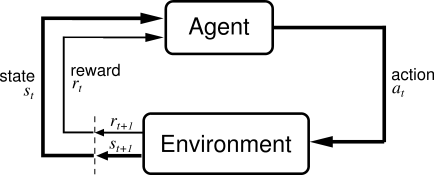Reinforcement Learning Problem Formulation
- Markov Chain (MC)
- Define (fully observable) states and memoryless (i.e., Markovian) state transitions
- Markov Reward Process (MRP)
- Indicate preferences through a reward function
- Markov Decision Process (MDP)
- Include decisions that can be controlled by an agent's policy
- Partial Observable MDP (POMDP)
- Deal with situations where the true state information isn't available
Markov Chain (MC)
- Markov Property: the current state determines the state transition probability, regardless the history (i.e., memoryless).
- The state transition can be deterministic or stochastic.
- States:
- State transition function:
- States:
Markov Chain, from Wikipedia.
Markov Reward Process (MRP)
- Indicate preferences through reward signals.
- States:
- State transition function:
- Reward function:
- rewards can be defined for each state transition (i.e., edges)
- or can be defined for each state (i.e., vertices)
- States:
Markov Decision Process (MDP)
- Include decisions that are controlled by an agent's policy.
- Involves an agent with its policy
- The agent's goal is to update its policy so as to maximize the total reward (return).
- States:
- Actions:
- Note that
- Note that
- State transition function:
- Reward function:
- rewards can be defined for each state transition (i.e., edges)
- or can be defined for each state (i.e., vertices)
- States:
Markov Decision Process, from Wikipedia.
Partial Observable MDP (POMDP)
- Include an observation function
- Agent does not observe the full state features, but can utilize either:
- the current observation
- the observation history
- the action-observation history
- the current observation
- The true state may be approximated by observations based on frame stacking, RNNs, transformers, etc.
SideNote: Markov Chains vs. Markov Decision Processes is analogous to Hidden Markov models (HMM) vs. POMDPs. 1
POMDP, from Section 9.5.6 of Artificial Intelligence: Foundations of Computational Agents.

The Agent-Environment Interface
- Training Phase of (Online) RL
- Agent collects experiences/data
- The state transitions & rewards can only be observed through sampling.
- Agent collects experiences/data
- Testing Phase of (Online) RL
- Agent applies the best learned policy.
The Agent-Environment Interface, from Section 3.1 of Reinforcement Learning: An Introduction.

Examples
Formulating tasks as MDPs for RL. Note that these are just minimal examples, where the actual formulation can be much more complicated.
1. Classification
- Goal: Maximize accuracy.
- State: Input Image
- Action:
DogorCat. - Reward:
2. Shortest Path
- Goal: Minimize total distance.
- State: Current vertex.
- Action: Move along an edge.
- Reward:
3. Console Game
- Goal: Maximize total score.
- State: Current game screen.
- Action: Game controls (Up, down, left, right, jump, etc.)
- Reward: Immediate score.
4. Robot Control
- Goal: Control robot to perform tasks.
- State: Joint angles, camera images, etc.
- Action: Target joint angles, etc.
- Reward:
-
See the topic on Markov Chain on Wikipedia. ↩

